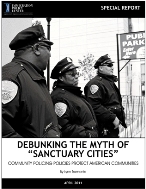 By Lynn Tramonte
By Lynn Tramonte
There is much confusion about the term “sanctuary city.” The term is often used derisively by immigration opponents to blast what are best described as community policing policies. Critics claim that these cities and states provide “sanctuary” to undocumented immigrants, but research shows that the opposite is true. In fact, community policing policies are about providing public safety services, not sanctuary, to both immigrant residents and the entire community. Crime experts, including hundreds of local police officers, have found that cities with community policing policies continue to work closely with DHS and have built bridges to immigrant communities that have improved their ability to fight crime and protect the entire community.
Historically, the federal government has enforced civil immigration law, and state and local police have focused on enforcing criminal law. However, propelled by increased frustration with the nation’s broken immigration system and by growing anti-immigrant sentiment, politicians’ demands for state and local police to take on an increased role in immigration enforcement have grown exponentially. This culminated in the passage of Arizona’s notorious SB1070 law in 2010, which would turn Arizona state and local police officers into deportation agents. Read more...
Published On: Tue, Apr 26, 2011 | Download File





